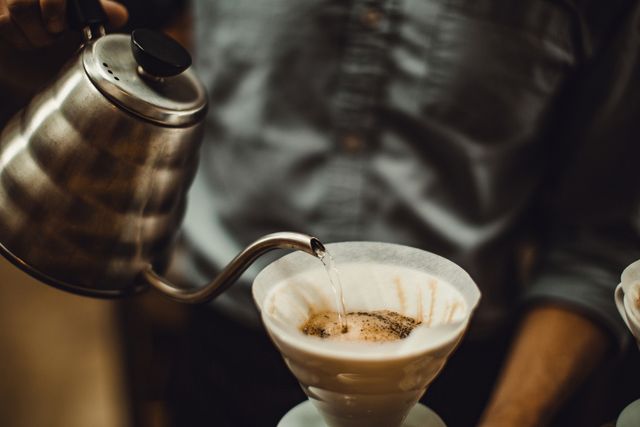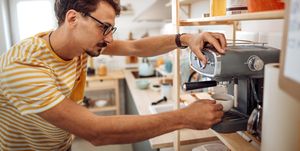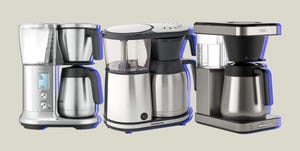Pour-over coffee is more prone to human error than any other coffee brewing method. Whether you’re using a Kalita, Hario, Chemex or another brewer, there are myriad ways you could be compromising your cup of joe. So to make sure you're brewing the best coffee possible, we've answered some common questions to keep you from making any of the usual pour-over mistakes during your next brew.
What temperature should the water be for pour-over coffee?
We all love our hot coffee, but if you’re using water that’s too hot, then you’re burning your coffee grounds. We tend to associate burnt flavors with bad coffee, so save yourself the disservice of drinking crap coffee by using water heated between 195°F and 205°F, per the Specialty Coffee Association’s recommended pour-over protocols.
What size should pour-over coffee grounds be?
Coffee ground size is not one size fits all. Pour-over coffee calls for a medium-coarse grind to ensure proper extraction. Grounds that are too fine will result in over-extracted, bitter coffee; grounds that are too coarse result in under-extracted, sour coffee. A medium-coarse grind will look like sea salt, and different beans might require some fine-tuning to get a coffee that achieves your desired taste.
Do I need to rinse the filter for pour-over coffee?
You aren’t imagining that papery taste in your coffee. Chemexes, Hario V60s and other drippers that use paper filters can impart an unpleasant flavor if they aren’t rinsed first. You might not notice the papery flavor if you’re brewing a dark roast bean, but the unsavory flavor will be prominent in light roast brews. Before you pour water to bean, place your filter in the dripper, pour over hot water and dump out the water that falls through. Plus, removing the papery taste with hot water is sort of a two-bird-one-stone situation, as you'll see in our next section.
Does the pour-over carafe need to be warm?
Brewing hot coffee into a cold container will result in lukewarm coffee once you’re ready to serve. Bringing your carafe (and mug, if you’re slightly crazy) up to temperature will make your coffee stay hotter for longer. You can accomplish this in the same step as rinsing your filter by using hot water for your rinse.
What is coffee blooming and why do I need to do it?
We’re all trying to get our cup of coffee as fast as possible, but you have to “bloom” your coffee grounds before going all in. Blooming requires pouring double the volume of water to coffee grounds to let the gases in the coffee release. Otherwise, if you just start drowning the beans, the carbon dioxide bubbles coming out of the coffee will prevent water from getting to the grounds to extract properly, which can throw off flavors dramatically.
What do I do while the coffee is blooming?
Great, so you realized you need to bloom your coffee grounds. The next step is to get them agitated — probably as agitated as you are right now after realizing you haven't been doing all of this stuff. After pouring the initial dose of water over the coffee, some grounds are going to clump up. Grab a spoon, chopstick or other stirring device and swirl the coffee and water to break up any clumps of grounds. (Just don't stir too aggressively or you risk tearing the filter.) Keeping the grounds from clumping up will ensure there's more contact between the water and the surface area of the grounds so your final cup tastes as intended.
Should I pour down the sides of the filter to loosen the stuck grounds?
When you’re pouring water over the grounds, make sure you’re actually hitting the coffee bed. As the water level drops and coffee grounds stick to the sides of the filter, you may be tempted to aim your water kettle at those orphaned grounds on the edges of the filter. Don’t do that. Any water that hits the side of the filter — or brewer — may slide straight down the side of the brewer into the brewed coffee below, making for a severely watered-down pot of joe.
How soon before brewing coffee should I grind the beans?
Oxygen is coffee’s greatest enemy. Grind your beans right before you’re about to start brewing. It may be more convenient to grind your beans the night before, but in doing so you’re exposing the grinds to aggressive oxidation and off-gassing, which will — even in one evening — warp the flavor of the brewed coffee. Also, be sure to keep your whole beans in airtight containers — either the bag they came in, or capsules like these from Fellow.





















